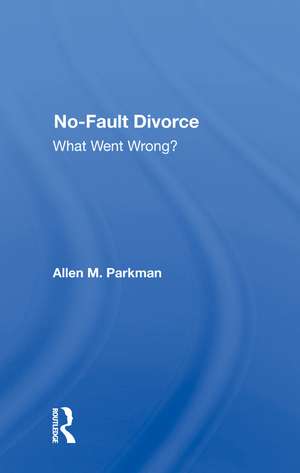No-fault Divorce: What Went Wrong?
Autor Allen M. Parkmanen Limba Engleză Hardback – 7 mai 2019
| Toate formatele și edițiile | Preț | Express |
|---|---|---|
| Paperback (1) | 380.74 lei 43-57 zile | |
| Taylor & Francis – 9 noi 2020 | 380.74 lei 43-57 zile | |
| Hardback (1) | 1000.27 lei 43-57 zile | |
| Taylor & Francis – 7 mai 2019 | 1000.27 lei 43-57 zile |
Preț: 1000.27 lei
Preț vechi: 1219.84 lei
-18% Nou
Puncte Express: 1500
Preț estimativ în valută:
191.40€ • 200.37$ • 158.37£
191.40€ • 200.37$ • 158.37£
Carte tipărită la comandă
Livrare economică 07-21 aprilie
Preluare comenzi: 021 569.72.76
Specificații
ISBN-13: 9780367004521
ISBN-10: 0367004526
Pagini: 232
Dimensiuni: 152 x 229 x 13 mm
Greutate: 0.45 kg
Ediția:1
Editura: Taylor & Francis
Colecția Routledge
Locul publicării:Oxford, United Kingdom
ISBN-10: 0367004526
Pagini: 232
Dimensiuni: 152 x 229 x 13 mm
Greutate: 0.45 kg
Ediția:1
Editura: Taylor & Francis
Colecția Routledge
Locul publicării:Oxford, United Kingdom
Cuprins
Preface -- Introduction -- Marriage and Divorce Laws -- The Economics of Marriage and Divorce -- The Introduction of No-Fault Divorce Statutes -- The Impact of No-Fault Divorce -- The Reform of No-Fault Divorce -- Appendix
Descriere
Since 1970, all the states adopted no-fault divorce statutes, which have had the unexpected effect of producing dire financial conditions for many divorced women and their children. In this important study, economist and lawyer Allen Parkman shows how no-fault divorce has systematically operated against the interests of these women and children. With rare economic and legal insight, Parkman argues that by changing the grounds for divorce without changing the laws that define and allocate property at divorce, the legal system created substantial injustices. The key mistake, he suggests, was in accepting a definition of property that did not include the income-earning capacity--human capital--of the individuals involved. Using human capital theory, Parkman criticizes current divorce law and presents a framework for reform that would reduce the injustices introduced by no-fault divorce. He concludes that a thorough reform, however, may require the changing of the grounds for divorce to mutual consent. This book is essential reading for scholars, professionals, and, indeed, for anyone interested in the health and future of the family and the well-being of women in contemporary U.S. society.
